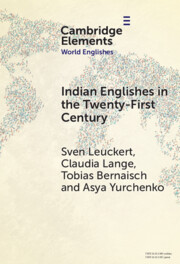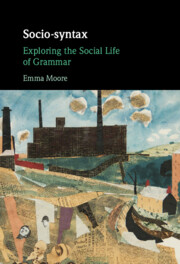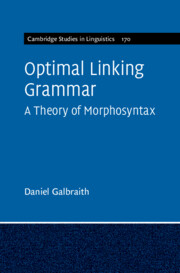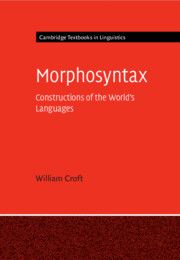49 results
5 - Grammar
-
- Book:
- A Practical Guide to Second Language Teaching and Learning
- Published online:
- 03 May 2024
- Print publication:
- 30 May 2024, pp 97-121
-
- Chapter
- Export citation
31 - Heritage Language Forms
- from Part 5 - Sociolinguistic and Geographical Approaches
-
-
- Book:
- The Cambridge Handbook of Slavic Linguistics
- Published online:
- 16 May 2024
- Print publication:
- 23 May 2024, pp 657-674
-
- Chapter
- Export citation
Morphosyntactic agreement in English: does it help the listener in noise?
-
- Journal:
- English Language & Linguistics , First View
- Published online by Cambridge University Press:
- 03 May 2024, pp. 1-22
-
- Article
-
- You have access
- Open access
- HTML
- Export citation

Indian Englishes in the Twenty-First Century
- Unity and Diversity in Lexicon and Morphosyntax
-
- Published online:
- 27 November 2023
- Print publication:
- 21 December 2023
-
- Element
- Export citation

Socio-syntax
- Exploring the Social Life of Grammar
-
- Published online:
- 19 October 2023
- Print publication:
- 02 November 2023
12 - Parameters of variation in the syntax of expressive suffixes: Case studies of Russian, German, Spanish and Greek
- from Comparative
-
-
- Book:
- Expressivity in European Languages
- Published online:
- 24 August 2023
- Print publication:
- 07 September 2023, pp 361-392
-
- Chapter
- Export citation
Cross-linguistic influence, limited input, or working-memory limitations: The morphosyntax of agreement and concord in Heritage Russian
-
- Journal:
- Applied Psycholinguistics / Volume 44 / Issue 5 / September 2023
- Published online by Cambridge University Press:
- 05 September 2023, pp. 941-968
-
- Article
-
- You have access
- Open access
- HTML
- Export citation
2 - The Development of Two Languages
-
- Book:
- Bilingualism Matters
- Published online:
- 29 June 2023
- Print publication:
- 20 July 2023, pp 18-38
-
- Chapter
- Export citation
9 - Syntax in OLG
-
- Book:
- Optimal Linking Grammar
- Published online:
- 20 April 2023
- Print publication:
- 27 April 2023, pp 193-254
-
- Chapter
- Export citation

Optimal Linking Grammar
- A Theory of Morphosyntax
-
- Published online:
- 20 April 2023
- Print publication:
- 27 April 2023
Learning second language morphosyntax in dialogue under explicit and implicit conditions: An experimental study with advanced adult learners of German
-
- Journal:
- Bilingualism: Language and Cognition / Volume 26 / Issue 5 / November 2023
- Published online by Cambridge University Press:
- 21 March 2023, pp. 984-997
-
- Article
-
- You have access
- Open access
- HTML
- Export citation
What Characterizes the Productive Morphosyntax of Norwegian Children with Developmental Language Disorder?
-
- Journal:
- Journal of Child Language , First View
- Published online by Cambridge University Press:
- 24 October 2022, pp. 1-24
-
- Article
-
- You have access
- Open access
- HTML
- Export citation
23 - The Development of the Heritage Language in Childhood Bi-/Multilingualism
- from Part Five - Socialization in Childhood Multilingualism
-
-
- Book:
- The Cambridge Handbook of Childhood Multilingualism
- Published online:
- 18 August 2022
- Print publication:
- 25 August 2022, pp 537-554
-
- Chapter
- Export citation
15 - Tonal Processes Conditioned by Morphosyntax
- from Part Three - Phonetic-phonological Issues in Chinese
-
-
- Book:
- The Cambridge Handbook of Chinese Linguistics
- Published online:
- 04 August 2022
- Print publication:
- 18 August 2022, pp 313-335
-
- Chapter
- Export citation

Morphosyntax
- Constructions of the World's Languages
-
- Published online:
- 04 August 2022
- Print publication:
- 04 August 2022
-
- Textbook
- Export citation
1 - Grammatical Constructions, Semantic Classes, and Information Packaging
- from Part I - Introduction
-
- Book:
- Morphosyntax
- Published online:
- 04 August 2022
- Print publication:
- 04 August 2022, pp 3-31
-
- Chapter
- Export citation
Social meaning in archival interaction: a mixed-methods analysis of variation in rhoticity and past tense be in Oldham
-
- Journal:
- English Language & Linguistics / Volume 26 / Issue 4 / December 2022
- Published online by Cambridge University Press:
- 25 July 2022, pp. 861-887
-
- Article
-
- You have access
- Open access
- HTML
- Export citation
The offline and online effects of processing instruction
-
- Journal:
- Applied Psycholinguistics / Volume 43 / Issue 4 / July 2022
- Published online by Cambridge University Press:
- 25 July 2022, pp. 945-971
-
- Article
-
- You have access
- Open access
- HTML
- Export citation
24 - Contact between English and Norman in the Channel Islands
- from Part Five - Contact and Language Structures
-
-
- Book:
- The Cambridge Handbook of Language Contact
- Published online:
- 02 June 2022
- Print publication:
- 30 June 2022, pp 635-654
-
- Chapter
- Export citation
Online processing of which-questions in bilingual children: Evidence from eye-tracking
-
- Journal:
- Journal of Child Language / Volume 50 / Issue 5 / September 2023
- Published online by Cambridge University Press:
- 26 May 2022, pp. 1082-1118
-
- Article
-
- You have access
- Open access
- HTML
- Export citation



